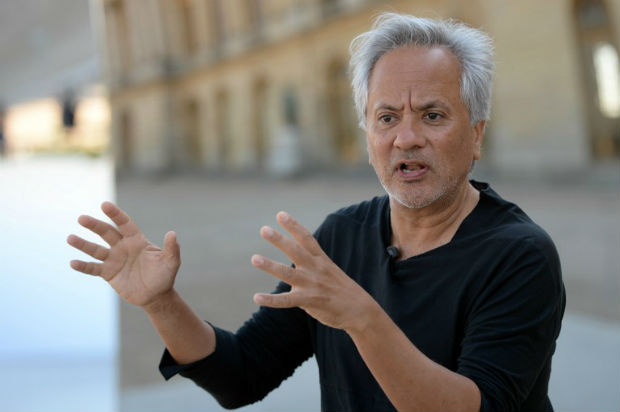‘Queen’s vagina’ sculpture at Versailles vandalized again

This file photo taken in Versailles on June 5, 2015 shows British contemporary artist of Indian origin Anish Kapoor speaking outside the Chateau de Versailles, ahead of the opening of “Kapoor Versailles”, an exhibition of Kapoor’s work that runs through June 9-November 1, 2015. A controversial sculpture by artist Anish Kapoor on display in the gardens of France’s Palace of Versailles, and which has become known as the “queen’s vagina”, was vandalized on September 6, 2015 for the second time. AFP
PARIS, France — A controversial sculpture by artist Anish Kapoor on display in the gardens of France’s Palace of Versailles, which is known as the “queen’s vagina”, was vandalized Sunday for the second time.
Officially known as “Dirty Corner,” the giant steel funnel that Kapoor himself has described as “very sexual” was covered in anti-Semitic graffiti, said Versailles president Catherine Pegard.
Phrases such as “Queen sacrificed, twice insulted”, “the second rape of the nation by deviant Jewish activism” and “Christ is king in Versailles” were daubed in white paint on the sculpture by the British-Indian artist.
President Francois Hollande condemned the vandalism as “hateful and anti-Semitic” in a statement and Prime Minister Manuel Valls took to Twitter to express his “disgust”.
“The anti-Semitic vandalism on the Kapoor artwork will be severely punished,” Valls wrote.
Article continues after this advertisementFrance’s Culture Minister Fleur Pellerin said the act of vandalism was an “attack on freedom of creation” and condemned the “unacceptable” phrases painted on the funnel.
Article continues after this advertisement“This is no more or less an act which reveals a fascist vision of art,” she said in a statement after going to Versailles to inspect the damage.
The steel-and-rock sculpture, which faces the royal chateau, is 60 meters (200 foot) long and 10 meters (33-foot) high, and attracts five million tourists a year.
“This act of intolerable violence against the work of an international artist shocks and saddens me,” Pegard told journalists.
Vandals with ‘royalist leanings’
Shortly after the sculpture was unveiled in June, vandals splattered it with yellow paint.
This time, the tapered funnel was sprayed with white slogans, as were the rocks surrounding it.
A source close to the investigation said the “subliminal message was that France has lost its shine of days gone by compared to other nations. A message with royalist leanings.”
“We know individuals with ultra-conservative leanings, we have some ideas about those who fit the profile,” the source added.
The sculpture is one of several by Kapoor which are on show in the gardens and inside one room of the palace until November.
Kapoor has described the piece as “the vagina of a queen who is taking power” but later appeared to step back from this description.
“The point is to create a dialogue between these great gardens and the sculptures,” he said before the display was unveiled.
Kapoor’s exhibition is one of the most controversial at Versailles since the authorities opened the palace and its grounds to contemporary artists, hosting works by American artist Jeff Koons in 2008 and by Japanese artist Takashi Murakami in 2010.
“The very controlled landscape of Versailles is drawn into instability.
“The grounds become uncertain and moving. Waters swirl. The mirrors that are so central to Versailles now distort it,” reads the description of Kapoor’s display.
“This world is perhaps about to tip over.”
Kapoor, who has said he wants sculpture to be about belief, passion or experience rather than form, has become known for his massive public works.
His work is not the first to spark anger in France.
In October 2014, vandals deflated a massive sculpture by American artist Paul McCarthy that was shaped like a sex toy at Paris’s Place Vendome.
McCarthy then decided to take down the work, which had both outraged and amused Parisians.